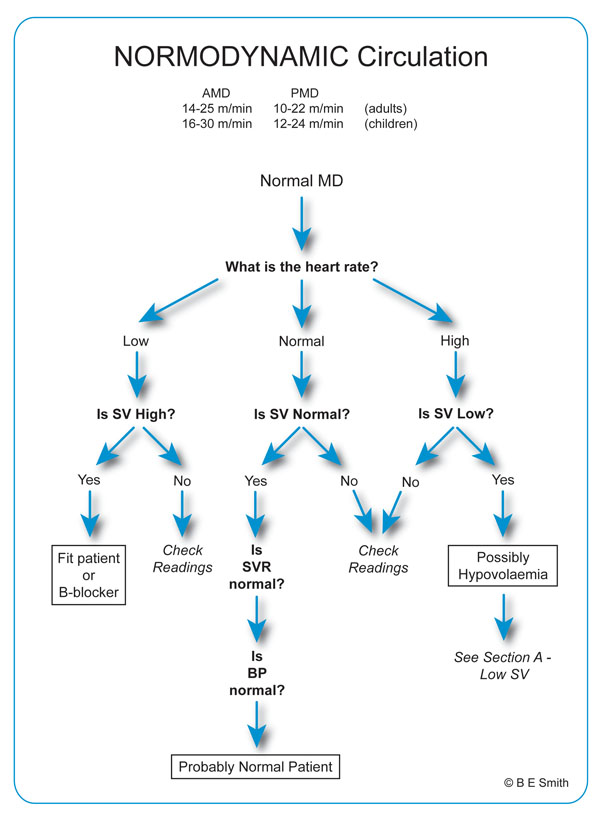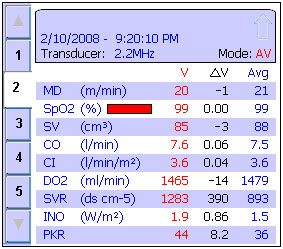Section B - Normodynamic Circulation.
The MD is between 14 and 22 m/minute (16-28 in a child). As a general rule, if the circulation is normodynamic then it is unlikely that there will be any major circulatory disturbance. Minor abnormalities may be seen which usually show inherent compensation within the circulation. This occurs in minor degrees of volume depletion for example, where a small reduction in SV is compensated for by an equivalent rise in HR, keeping CO and perfusion within the normal range. MD will therefore be normal.

This is a 24 year old 78kg male, immediately prior to elective surgery, after fasting for almost 9 hours. Can you tell?

Initially this looks normal, but let’s look at some of the detail.
His MD is normal at 20 m/min. His BSA is 1.76m2, so why has he got a DO2 of 1465 ml/min and a DO2I of 832ml/min/m2 – almost 40% in excess of normal (600ml/min/m2). His CI is a little high at 3.6 considering that he’s lying in bed. You haven’t been given his HR but it must be 7,600/83 or about 91/min. Maybe just up a little? His SV is 1.1ml/Kg. Is this just a little low? His SMII is in the middle of the normal range. The answer is revealed when we look at PKR. His PE:KE ratio is 44:1. In a fit young man of his age 25:1 or 30:1 would be more like it. He is slightly vasoconstricted, SVR of 1283. His BP was slightly high at 136/92 (MAP of 112mmHg).
So what does all this mean? This is a man who is anxious, presumably because he is going to have his hernia repaired within the hour. His SV is a little low and his HR, PKR, SMII and SVR are all a little high. Is this because he has had no fluid intake for the last 9 hours leaving him dry as well as anxious? It looks like it.
This is what I meant when I said that even in a normodynamic circulation there may be subtle compensations going on within the circulation. Haemodynamics can spot some surprisingly fine details!
Sometimes confirming that the circulation is normal is a very positive finding. If this man had been severely dehydrated and we had been volume replacing him, then these figures would show that we had almost achieved our goal. He probably just needs another litre of fluid and the numbers would all be close to normal. So normodynamic circulation is actually our end point or therapeutic goal in the treatment of any hyperdynamic or hypodynamic state. If the patient is normodynamic then we have “cured” them; if they’re not, then we should continue with our therapy.
Ensuring normodynamic circulation before discharge would seem prudent, whilst abnormal measurements suggest further observation and treatment may be required. Before discharging a child from ED with what appears to be a non-specific febrile illness you might like to think about this! |

